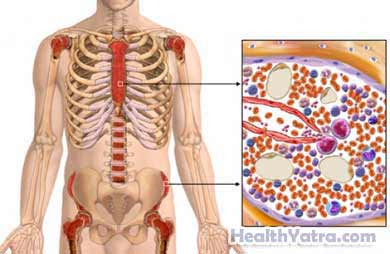تعريف
Stem cells produce red blood cells, white blood cells, and platelets. In some cases, stem cells in your bone marrow may not be functioning well or need to be destroyed to help treat a disease. If this happens, you will need new stem cells.
During this procedure, healthy stem cells are taken from a donor’s:
- Bone marrow (bone marrow transplant or BMT)
- Blood (peripheral blood stem cell or PBSC)
The stem cells will be injected into your vein. The new cells travel through the bloodstream to your bone cavities. It may take about a month for the donor stem cells in the bone marrow to begin to function fully. If the transplant is successful, new bone marrow cells will produce healthy red blood cells, white blood cells, and platelets.
Stem cell transplantation may be done using:
- Stem cells that were taken from your own bone marrow or blood and stored
- Stem cells from a donor

أسباب هذا الإجراء
This procedure is done if the stem cells in your bone marrow are not functioning or are deficient. This may be caused by:
- العدوى
- Cancer (eg, leukemia, lymphoma)
- Cancer treatment (eg, chemotherapy, radiation)
- Immunodeficiency disorders
- Severe anemia (eg, aplastic anemia)
- Blood disorders (eg, sickle cell disease, thalassemia)
المضاعفات المحتملة
Complications are rare, but no procedure is completely free of risk. If you are planning to have a stem cell transplant, your doctor will review a list of possible complications, which may include:
- Infection—until the donor blood-forming cells begin to function
- Rejection of the donor stem cells
- Acute graft versus host disease (when the immune cells in the donor’s bone marrow attack your tissue)
Possible complications for the donor include:
- نزيف
- العدوى
Stem cell transplant is usually avoided if you have:
- Disease of the heart, lungs, liver, or kidneys
- مرض السكري
Be sure to discuss the risks with your doctor before the transplant.
ما يمكن توقعه
قبل الإجراء
The donor will be carefully tested to check for diseases. Both you and the donor will be tested to ensure that your tissues are compatible. In order for the transplant to be successful, certain markers on the blood cells and bone marrow cells, called HLS types, must match.
As the recipient, you will be given medication to suppress your immune system. This is to prevent your body from rejecting the donor stem cells. In the weeks prior to the transplant, you may have to have:
- العلاج الكيميائي
- علاج إشعاعي
This process is called “conditioning.” It will rid the body of diseased cells and clear the bone marrow cavities for the new bone marrow.
التخدير
- Donor—general anesthesia to block pain and keep the donor asleep through the procedure; given through an IV in the hand or arm
- Recipient—will not need any anesthesia
وصف الإجراء
If the stem cells will be from the donor’s bone marrow (BMT), the doctor will clean an area of the donor’s hip. A hollow needle and syringe will be used to remove the bone marrow. The doctor will make several small punctures. This is to harvest enough bone marrow for the transplant (1-2 quarts). Lastly, the wounds will be covered with bandages.
If the stem cells will be from the donor’s blood (PBSC), the doctor will stick a needle in the donor’s large vein or veins in the arms. A machine will receive blood from the vein. This machine will spin the blood so that the stem cells are concentrated. The rest of the blood will be given back to the donor. The doctor will cover the puncture wounds with bandages. This procedure may require more than one blood donation. The donor may also be required to take pills that cause more stem cells from the bone marrow to go into the blood.
The donated stem cells will be filtered. Next, the doctor will administer the cells through a small, flexible tube, called a catheter, into one of your large veins.
مباشرة بعد الإجراء
The donor will recover quickly. You, the recipient, will need to be placed in isolation. This is to avoid infection until the new stem cells in the bone marrow begin to produce infection-fighting cells.
كم من الوقت سيستغرق ؟
- Donor
- BMT—about 30 minutes
- PBSC—several hours
- Recipient—several hours
كم هو مؤلم ؟
- Donor:
- If the procedure done is a BMT, then the donor will have general anesthesia during the transplant. There may be pain and discomfort after the anesthesia wears off.
- If the procedure done is a PBSC transplant, then the donor will have pain from the needle sticks.
- Recipient—There will not be pain while the stem cells are infused. You may have some nausea. This can be treated with medication.
متوسط الإقامة في المستشفى
- Donor
- For BMT—overnight
- For PBSC—several donations (each donation lasts a couple of hours)
- Recipient—1-2 months
رعاية ما بعد العملية
The donor may receive:
- دواء الالم
- المضادات الحيوية لمنع العدوى
أثناء تعافيك في المستشفى ، قد تتلقى الرعاية التالية:
- Medication that keep your immune system low to decrease the chance of transplant rejection
- المضادات الحيوية لمنع العدوى
- Platelets, plasma, and red blood cell transfusions to prevent bleeding and anemia
- Frequent blood tests to monitor whether the new stem cells in the bone marrow are taking hold or being rejected
استدعاء الطبيب
بعد مغادرة المستشفى ، اتصل بطبيبك في حالة حدوث أي مما يلي:
- الغثيان و/أو القيء
- ألم حاد
- New onset of pain (more than 24 hours after the transplant)
- Redness, swelling, increasing pain, excessive bleeding, or discharge from the catheter site
- Signs of infection; including fever and chills
- متسرع
- إسهال
في حالة الطوارئ ، اتصل على المساعدة الطبية على الفور.
